
Articles on the Anthropocene
In-depth articles on the Anthropocene
What is the forest carbon sink?
The forest carbon sink is a transitory phase, not a function of forests
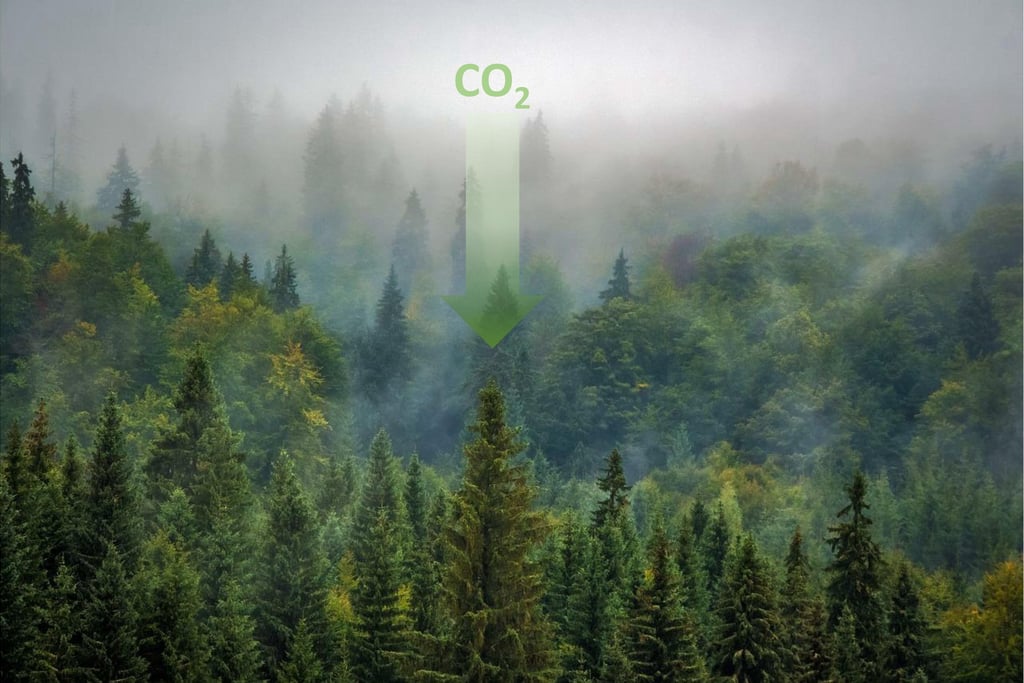

The forest as a carbon sink? Source: Image by Robert Balog from Pixabay, https://pixabay.com/fr/photos/des-arbres-for%C3%AAt-brouillard-brumeux-975091/.
Forests, like ecosystems in general, are often described as fulfilling essential functions that provide us with valuable services, commonly referred to as “ecosystem services”*. The term “multifunctionality” is used to highlight the diversity of these functions. Among them, carbon sequestration now holds a central place in public debate. You may have heard that forests act as a “carbon sink” — or even a “carbon pump” — helping to mitigate the greenhouse effect and, consequently, climate change.
This article proposes to take a closer look at how the forest carbon sink works. In doing so, we’ll see that it is not an intrinsic or stable function of forests, but rather a transitory phenomenon embedded in a broader cycle.
A global geophysical experiment
Since 1850, our thermo-industrial civilization has undertaken a gigantic geophysical experiment by emitting more than 2,500 billion tons (or gigatons) of CO₂ (i.e., over 675 gigatons of carbon, GtC, since 1 ton of CO₂ contains about 0.27 tons of carbon**) into the atmosphere [1], raising atmospheric CO₂ concentration from 280 parts per million (ppm) in 1850 to over 420 ppm in 2024 [2, 3]! This is an absolutely staggering evolution when viewed in the long-term context (Figure 1). Emissions have never been higher than they are today, reaching around 40 billion tons of CO₂ per year (~11 GtC) [3].
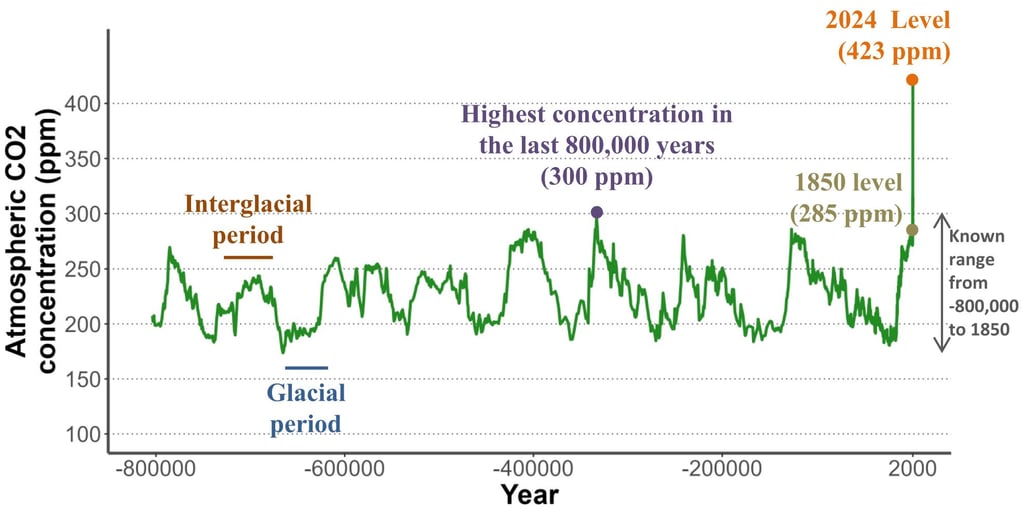

Figure 1: Evolution of atmospheric carbon dioxide (CO₂) concentration over the past 800,000 years. Over the past several hundred thousand years, CO₂ levels have fluctuated in connection with alternating glacial and interglacial periods, but have always remained below 300 ppm. Since 1850, mainly due to the combustion of fossil fuels by human activity, CO₂ concentration has risen from 280 ppm to over 420 ppm today! Data source: Our World In Data [4].
This ultra-rapid enrichment of the atmosphere with CO₂, a greenhouse gas, has an obvious consequence: a similarly abrupt rise in Earth’s surface temperature [5]. The change is so sudden and of such magnitude that it poses an existential threat to our thermo-industrial civilization, which has finally come to realize that something must be done to limit the phenomenon.
However, since our civilization has made economic growth its founding axiom and "raison d’être", it is incapable of questioning this radical dogma, despite its tight and persistent link with CO₂ emissions. We are therefore on the lookout for any means to mitigate the greenhouse effect without having to challenge our ideological foundations and associated lifestyle. One such means is summed up in two little words: “carbon sink.”
What is a carbon sink?
In general terms, a carbon sink is something that absorbs more CO₂ than it emits into the atmosphere, thus tending to reduce atmospheric CO₂ levels. Conversely, a carbon source emits more CO₂ than it absorbs, thereby increasing atmospheric CO₂ levels.
Two major natural*** carbon sinks have been identified on Earth: the oceans and terrestrial vegetation. Together, they absorb about 55% of human CO₂ emissions (Figure 2) [3]; without these sinks, atmospheric CO₂ levels would have risen much more, and climate change would be even more severe.
In what follows, we will focus on the functioning of the “forest carbon sink,” which represents the main component of the sink effect exerted by vegetation, even though it does not account for the majority of the Earth’s carbon stock. Indeed, other ecosystems such as grasslands, wetlands, or savannas can store significant amounts of carbon, particularly in their soils. We will return later to this essential distinction between stock and sink.
Currently, the forest carbon sink alone contributes to absorbing about 30% of anthropogenic CO₂ emissions [6, 7]. While the concept of the forest carbon sink is simple in general terms, it involves a certain complexity in detail, and is therefore often misunderstood and surrounded by many misconceptions. One of the most widespread is the belief that the carbon sink is an intrinsic and permanent property of the forest. The forest is thought to “play the role” of a carbon sink [8, 9], as if it were a natural function and a service it is inherently and perpetually meant to provide. Let us now examine in more detail how the forest carbon sink works, in order to better understand what it truly means.
The forest carbon sink at the tree level
Let’s begin with the central element without which a forest cannot exist: the tree. Like all living beings, a tree breathes, feeds, and excretes waste. But a fundamental difference sets it apart: while we must consume other living beings to feed ourselves, trees have the extraordinary ability to produce their own matter from a few simple elements — water and minerals from the soil, and carbon dioxide (CO₂) from the air.
This biological marvel is based on a well-known mechanism: photosynthesis. Through this process, the tree captures atmospheric CO₂ and releases oxygen (O₂). At the same time, like all living organisms, it respires: it consumes O₂ and releases CO₂. As long as the tree is growing, it captures more carbon through photosynthesis than it emits through respiration. It then accumulates carbon in its tissues — wood, leaves, roots — and thus acts as a carbon sink.
It is essential here to distinguish between two often-confused concepts:
Carbon stock: the total amount of carbon contained in the tree’s body at a given moment.
Carbon sink: the increase in that stock over time — in other words, the tree’s net growth.
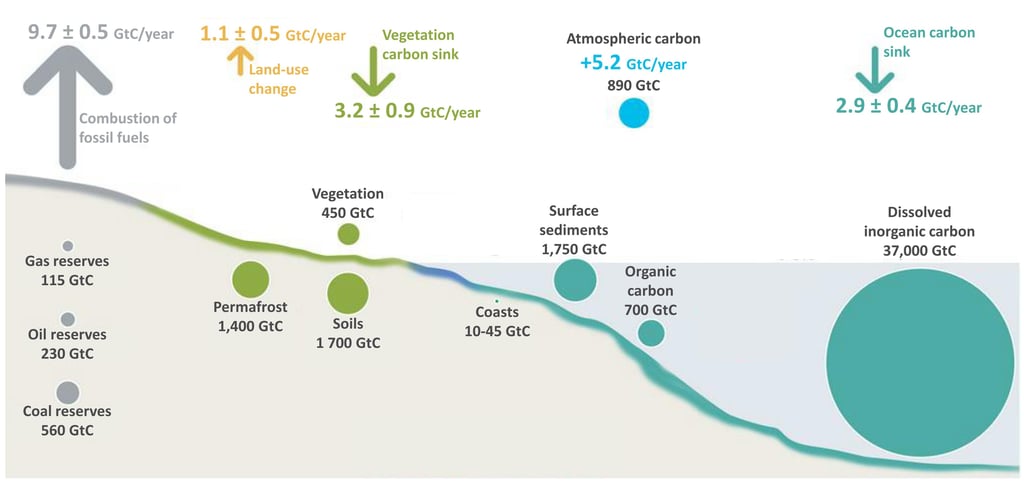

Figure 2: The global carbon cycle, showing the main carbon stocks and fluxes. Human activity tends to emit around 11 gigatons of carbon (GtC) per year (9.7 GtC from burning fossil fuels, plus 1.1 GtC from land-use change), which contributes to increasing the atmospheric carbon stock. However, vegetation and oceans tend to absorb more carbon than they emit, thus acting as carbon sinks that absorb about 55% of human CO₂ emissions (3.2 GtC per year by vegetation and 2.9 GtC by oceans, totaling 6.1 GtC per year). Source: adapted from https://essd.copernicus.org/articles/17/965/2025/ [3].
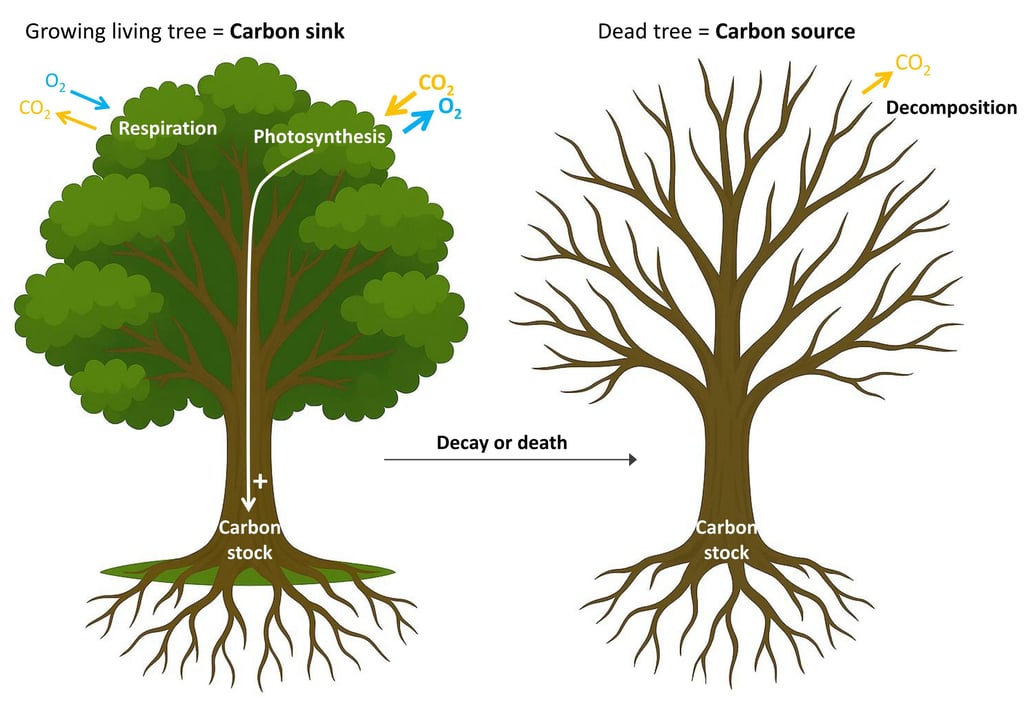

Figure 3: The carbon cycle at the scale of an individual tree, showing the carbon stock (the tree’s biomass) and carbon fluxes (photosynthesis and respiration). When the tree is growing, it captures more carbon through photosynthesis than it emits through respiration; the carbon is then added to the tree’s carbon stock, which increases over time — making the tree a temporary carbon sink. Conversely, when the tree dies, all the carbon stored in its biomass eventually returns to the atmosphere. The tree then becomes a temporary carbon source. To be more complete, one should also consider the dynamics of litter (leaves and branches that fall to the ground, where they are either decomposed — releasing carbon back into the atmosphere — stabilized, or mineralized).
Beyond its mode of nourishment, the tree also stands out for its ability to develop gigantic structures. This is made possible in particular by wood — a material that is both lightweight and strong, composed of long carbon chains produced through photosynthesis. Thanks to this mechanical support, the tree can reach considerable heights. Another remarkable trait: its longevity. Some trees live for several centuries, even several millennia!
It is this combination — size and lifespan — that enables the tree to serve as both a significant and long-lasting carbon stock and sink. As long as it continues to grow, it captures atmospheric CO₂, incorporates it into its biomass, and thus has a dual effect: it is both a reservoir (stock) and an active absorber (sink) of carbon. In temperate climates, this dynamic is clearly visible in the annual growth rings that can be seen in a cross-section of the trunk: each ring marks a year of biomass accumulation — and therefore carbon.
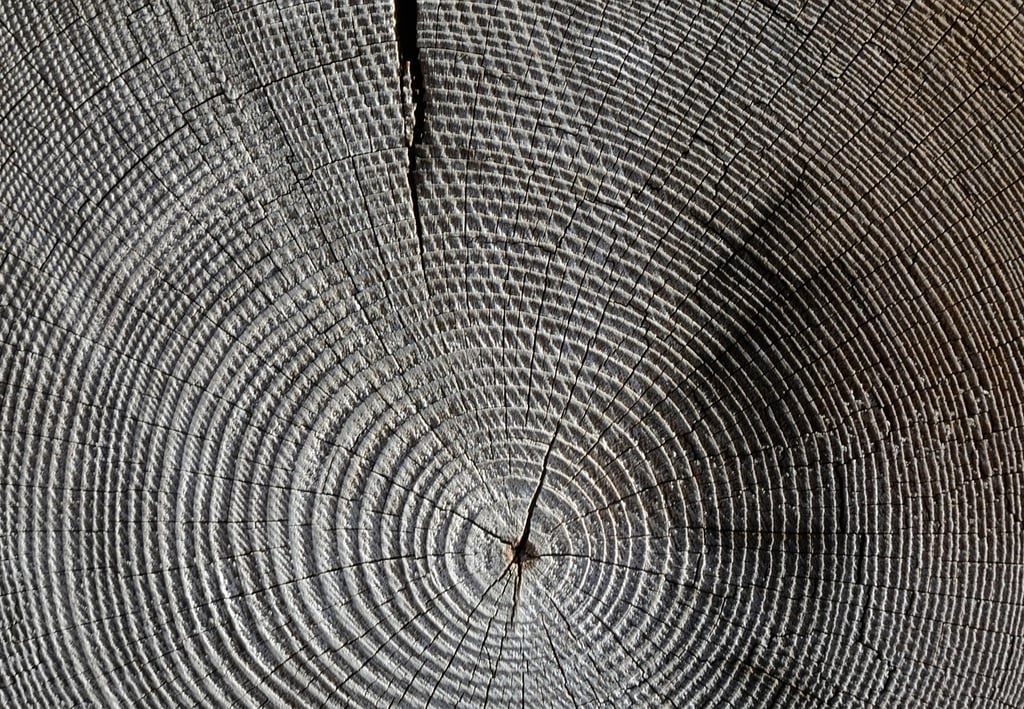

Figure 4: Stacked annual growth rings in a cross-section of a tree trunk. Each ring reflects the accumulation of biomass and carbon in the tree’s body during a given year; as long as the tree continues to grow, it functions as a carbon sink because the amount of carbon stored in its biomass increases year after year. Image source: Manfred Antranias Zimmer via Pixabay (https://pixabay.com/fr/photos/bois-cernes-annuels-grain-structure-618673/).
But this sink function is not eternal. Eventually, when the tree dies, all the carbon it stored ends up returning to the atmosphere. The tree then becomes a carbon source. This return can be fast or slow, depending on the circumstances:
If the tree burns in a wildfire or is used as firewood, the carbon accumulated over decades is released almost instantly.
Conversely, if the tree dies naturally and decomposes slowly in the forest, or is turned into furniture or construction material, the carbon can remain stored for many years or even decades (even though the tree is no longer a carbon sink, its matter can continue to store a significant amount of carbon for a long time).
In all cases, it’s a cycle: the carbon captured by the tree always ends up returning to the atmosphere. The cycle may be short or long, but it reminds us that the forest carbon sink is not a permanent mechanism or a definitive storage — it’s a dynamic process over time.
The carbon sink at the forest level
At the level of an individual tree, the carbon cycle is fairly easy to understand: a transitory carbon sink during growth, followed by a transitory carbon source during decline, decomposition or combustion.
Things become more complex at the forest level, due to the sheer number of trees involved. For example, in the French Meurthe-et-Moselle department, there are over 100 million trees****. In the French Grand Est region? Over 1 billion. In France? Over 10 billion. Worldwide? Several trillion (3,000 billion) [10]!
To estimate a forest’s carbon balance, we must integrate the trajectories of this multitude of individuals. While some trees are growing and absorbing carbon, others are just sprouting, some are declining, others dying or being harvested. The forest is a living system in constant renewal, where “sink trees” and “source trees” coexist. This collective dynamic determines whether the forest as a whole acts as a carbon sink or source at any given time.
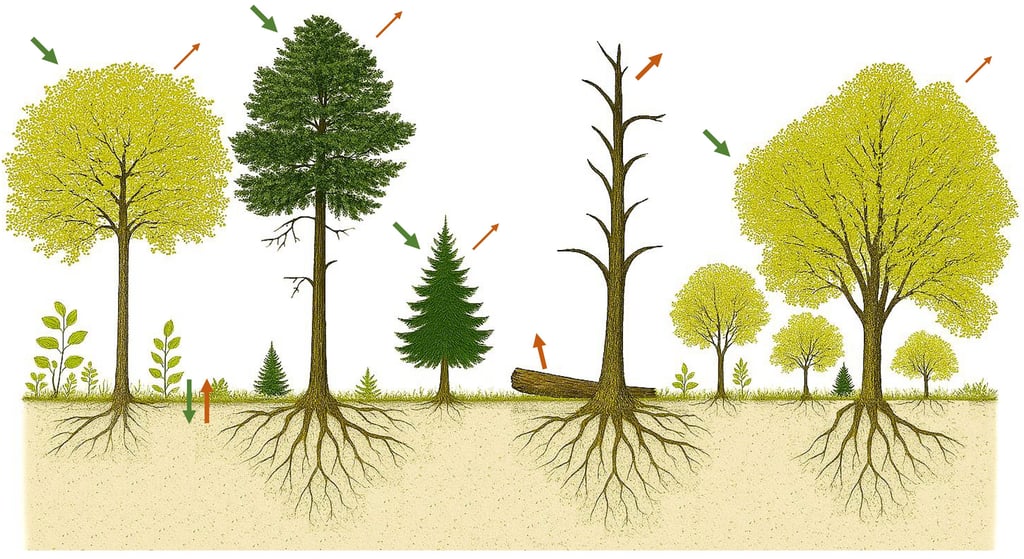

Figure 5: The carbon balance at the scale of a forest. To calculate the carbon balance of a forest, one must account for all incoming fluxes (green arrows) and outgoing fluxes (red arrows). This is a complex task, as the forest consists of a multitude of trees at different stages of development. It is also necessary to consider dead trees, litter, and deadwood on the ground, as well as what happens in the soil and the potential uses of harvested wood (not shown in this diagram).
The forest carbon sink is a transitory phase, not a function
Even though the dynamics are more complex at the forest level, it’s clear that the carbon sink remains a transitory phase in a cycle, not an intrinsic or permanent property. In other words, the forest is not a bottomless sink.
The “carbon sink” effect depends on the overall dynamics of all components of the forest carbon balance. For example:
A young forest tends to act as a carbon sink due to rapid tree growth, though it holds a small carbon stock.
A mature forest may reach equilibrium, where incoming carbon (from growth) is balanced by outgoing carbon (from decomposition and disturbances). In this case, the forest is “carbon neutral.” Yet its trees may hold a vast carbon stock.
Contrary to popular belief, old-growth forests can still be carbon sinks [13]. Likewise, a very large tree can absorb far more carbon than a small sapling***** [14].
Moreover, to properly assess a forest’s carbon balance, we must consider more than just living trees. Other essential components include:
Deadwood and litter: which decompose and release or stabilize carbon.
Soil: which stores more carbon than the trees’ aboveground biomass [11, 12].
These reservoirs contain vast amounts of carbon in the form of organic matter or mineral compounds. Their dynamics — decomposition, mineralization, stabilization — directly influence carbon fluxes between the forest and the atmosphere.
Another key factor: wood usage. As we’ve seen, the fate of carbon in harvested biomass depends heavily on how the wood is used. Thus, a forest’s carbon balance depends not only on what happens within it, but also on how its wood is used. The entire chain — from tree growth to final wood use — determines the forest’s carbon balance.
There’s more to life than the sink
The carbon sink alone is not enough to evaluate a forest’s contribution to the global carbon balance. The carbon stock is just as fundamental. Consider a deliberately exaggerated example: A mature forest with very large trees is in equilibrium and no longer acts as an active carbon sink. Some might complain: “This forest isn’t doing its job anymore — let’s rejuvenate it!” So the trees are cut and replaced with fast-growing saplings. Result: an immediate carbon sink effect. But at what cost? The massive carbon stock in the mature forest is lost — released into the atmosphere or removed from the forest system. The overall carbon balance is thus largely negative.
In a world dominated by economic logic, a financial analogy helps clarify the difference between stock and flow:
The amount of money in a bank account = carbon stock.
The change in that amount over time = carbon sink (positive or negative).
Would you rather have €100 with 10% interest (small stock, high sink) or €1,000,000 with 0% interest (large stock, no sink)? In carbon terms, a forest with a small or even zero sink is not necessarily a problem if it simultaneously serves as a massive carbon reservoir. In other words, a forest that is no longer a carbon sink is not inherently a bad thing — even from a strictly “carbon” perspective (not to mention other essential aspects like biodiversity, soil health, etc., which are beyond the scope of this article).
Ultimately, the diagnosis depends on why the forest is no longer a sink. As we’ve seen, the absence of a sink effect may simply reflect a normal phase in the forest cycle. However, the situation becomes concerning when a forest stops acting as a carbon sink due to a general decline in its vitality — tree dieback, soil degradation, increased disturbances... In the next article, we’ll see that the current global trend leans more toward this second scenario, posing a significant threat to the continuation of the forest carbon sink effect in the near future.
Notes
*This terminology of “role,” “function,” or “service” reflects a highly anthropocentric view, closely aligned with creationist thinking. It’s based on a human/nature dualism that suggests nature was created to serve us, and that the functions necessary to provide these services are intrinsic properties meant to last forever.
**This is due to the molar mass of carbon (C) and oxygen (O) atoms in a CO₂ molecule. Carbon has a molar mass of 12 g/mol, and oxygen 16 g/mol. A CO₂ molecule thus weighs 44 g/mol (12 + 2×16). To convert CO₂ mass to carbon equivalent, multiply by 12/44 ≈ 0.27. To convert carbon to CO₂, multiply by 44/12 ≈ 3.67.
***This article does not address artificial carbon sinks — a dream of geoengineering — whose potential remains negligible compared to the scale of the problem [15].
****Source: National Forest Inventory (NFI) by the French National Institute of Geographic and Forest Information (IGN) (https://ocre-gp.ign.fr/ocre). This count includes only “measurable” trees, i.e., those with a diameter greater than 7.5 cm at 1.30 m height.
*****Which makes perfect sense: even if its relative growth rate (e.g., ring width) is lower, a very large tree, due to its size and leaf surface area, produces far more organic matter than a small, young tree.
References
[1] S. Evans, « Analysis: Which countries are historically responsible for climate change? », Carbon Brief, 2021. https://www.carbonbrief.org/analysis-which-countries-are-historically-responsible-for-climate-change/
[2] H. Ritchie, P. Rosado, et V. Samborska, « Climate Change. Data adapted from NOAA Global Monitoring Laboratory, United States Environmental Protection Agency », 2025. https://archive.ourworldindata.org/20250624-125417/grapher/co2-long-term-concentration.html
[3] P. Friedlingstein, M. O'Sullivan, M.W. Jones, R. Andrew et al., « Global Carbon Budget 2024 », Earth Syst. Sci. Data, 17, 965–1039, 2025. https://doi.org/10.5194/essd-17-965-2025
[4] H. Ritchie, P. Rosado, et M. Roser, « CO₂ and Greenhouse Gas Emissions », Our World In Data, 2023. https://ourworldindata.org/co2-and-greenhouse-gas-emissions
[5] IPCC, « IPCC, 2021: Summary for Policymakers ». In: Climate Change 2021: The Physical Science Basis. Contribution of Working Group I to the Sixth Assessment Report of the Intergovernmental Panel on Climate Change [Masson-Delmotte, V., P. Zhai, A. Pirani, S.L. Connors, C. Péan, S. Berger, N. Caud, Y. Chen, L. Goldfarb, M.I. Gomis, M. Huang, K. Leitzell, E. Lonnoy, J.B.R. Matthews, T.K. Maycock, T. Waterfield, O. Yelekçi, R. Yu, and B. Zhou (eds.)], 2021. https://www.ipcc.ch/report/ar6/wg1/chapter/summary-for-policymakers/
[6] Yude Pan et al., « A Large and Persistent Carbon Sink in the World’s Forests », Science 333,988-993, 2011. https://www.science.org/doi/10.1126/science.1201609
[7] Y. Pan, R.A. Birdsey, O.L. Phillips, et al., « The enduring world forest carbon sink », Nature 631, 563–569, 2024. https://www.nature.com/articles/s41586-024-07602-x
[8] Académie des sciences, « Communiqué de presse | Forêt et changement climatique : menace sur le puits de carbone forestier français », Académie des sciences, 2023. https://www.academie-sciences.fr/communique-de-presse-foret-et-changement-climatique-menace-sur-le-puits-de-carbone-forestier
[9] P. Mouterde, « La forêt française, un puits de carbone en péril », Le Monde, 2023. https://www.lemonde.fr/planete/article/2023/06/06/la-foret-francaise-un-puits-de-carbone-en-peril_6176474_3244.html
[10] T. Crowther, H. Glick, K. Covey, et al., « Mapping tree density at a global scale », Nature 525, 201–205, 2015. https://www.nature.com/articles/nature14967
[11] R. K. Dixon et al., « Carbon Pools and Flux of Global Forest Ecosystems », Science 263, 185-190 1994. https://www.science.org/doi/10.1126/science.263.5144.185
[12] R. Lal, « Forest soils and carbon sequestration », Forest Ecology and Management 220, 242-258 2005. https://www.sciencedirect.com/science/article/pii/S0378112705004834
[13] S. Luyssaert, E.D. Schulze, A. Börner, et al., « Old-growth forests as global carbon sinks ». Nature 455, 213–215, 2008. https://www.nature.com/articles/nature07276#citeas
[14] N. Stephenson, A. Das, R. Condit, et al., « Rate of tree carbon accumulation increases continuously with tree size », Nature 507, 90–93, 2014. https://www.nature.com/articles/nature12914
[15] Transition énergies, « La plus grande usine de capture du CO2 dans l’atmosphère est entrée en service en Islande », 2024. https://www.transitionsenergies.com/la-plus-grande-usine-de-capture-du-co2-dans-lamosphere-est-entree-en-service-en-islande/
Conclusion
The carbon sink is not a function, role, or intrinsic property of forests. It is a transitory phase within a broader cycle, marked by constant carbon exchanges between the forest and the atmosphere.
This phase depends on many factors: tree growth, of course, but also mortality, natural regeneration, and the accumulation and decomposition of organic matter in soils.
For several decades, forests have indeed phad a major carbon sink effect. And fortunately so: without this contribution, the greenhouse effect and global warming would have been far more severe.
But a pressing and legitimate question now arises: will forests continue to have thus effect in the years to come? Can we truly rely on the persistence of this “sink” effect to avoid questioning our thermo-industrial development model?
The answer in the next article.
Henri Cuny
